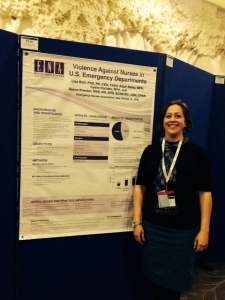Happy New Year and welcome to 2015! I’m thrilled to begin my tenure as your 2015 president. As we embark on our 45th anniversary, let us first and foremost celebrate our organization and the leaders who have brought us this far. We must recognize everyone who has dedicated themselves to our organization, from co-founders Anita Dorr, RN, FAEN, and Judith C. Kelleher, MSN, RN, CEN, FAEN, to our chapter, state, and national leaders over the past 45 years. I would like to express my congratulations and sincere gratitude for your work and accomplishments.
For 2015, our focus must be on value and stabilization. First, what do you value about your Emergency Nurses Association membership? Is it the discount for courses or the opportunity to receive the Journal of Emergency Nursing and ENA Connection? The fundamental question is, what can ENA do to keep our nurses, other emergency department personnel, patients and their families safe while helping our members provide exceptional, skilled emergency care?
We also must identify our members’ needs. Your ENA Board of Directors looks at the 40,000+ membership as a whole. Your Board works alongside the talented ENA staff to identify the future of emergency nursing and plan our future to protect our nurses and those we serve. We want to hear from you. Let us know what is working and what needs improvement. As your president, I will focus on identifying the needs of our members. This will give your Board the assessment information it needs to make decisions that will strengthen our organization and benefit all members. As you see our surveys this year, please take the time to complete them to have your voice heard.
Stabilization is another important topic for 2015. In recent months, Ebola and workplace violence have been recognized internationally as issues affecting emergency nurses. ENA continually brings the concerns of emergency nurses to the public, legislators, and other professional healthcare organizations. When these crises arise we are able to partner and build relationships with other associations and public entities, making our association stronger.
We have also identified the areas needing improvement. For example, we are working rigorously to improve the structure of our work teams, committees, and advisory councils and increasing our partnerships with affiliated boards. We remain focused on our fiduciary responsibility to ensure ENA’s current and future success. This is our year to make a difference by partnering with members, committees, affiliated ENA boards, staff, and outside organizations to look at improving emergency medical care at home and globally. I invite all of you to participate in innovative, exciting events, such as Day on the Hill, April 28-29, in Washington, D.C., and our first combined conference, Emergency Nursing 2015 in Orlando, Fla., Sept. 28 – Oct. 3.
We have always solicited member input and will continue to do so. As mentioned in my president-elect statement, please wear your angel wings of hope and passion to drive us forward in a collective and professional voice of emergency nursing practice. Please always communicate not just what ENA can do for you or what you can do for ENA, but most important, what we can accomplish together.
Welcome to 2015 – this is our year!




